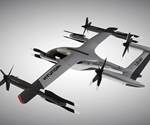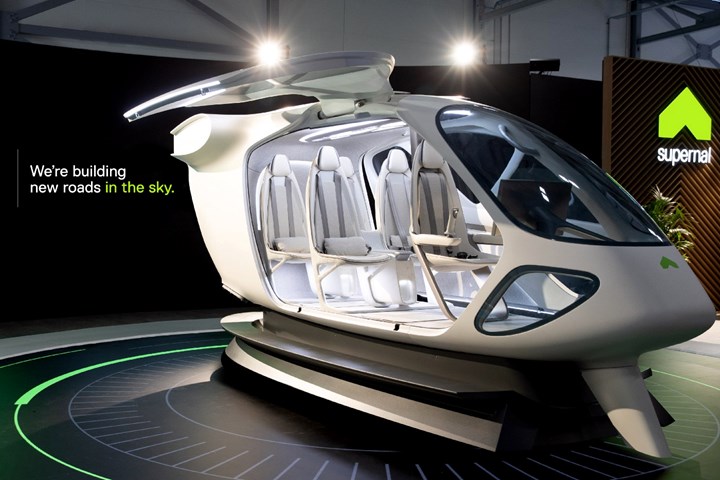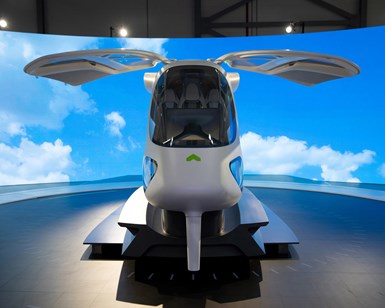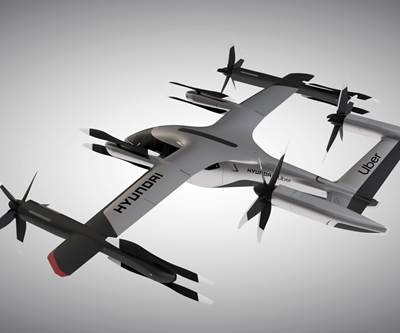Hyundai Motor, Supernal unveil eVTOL vehicle cabin concept
Concept details — such as CFRTP material incorporation, a biomimetic design and a focus on safety — provide a first look at how Hyundai integrate its mobility capabilities to develop commercial urban, regional air vehicles.
Supernal (Washington, D.C., U.S.) has revealed its initial electric vertical takeoff and landing (eVTOL) vehicle cabin concept, — comprising composite materials, amongst others — providing the first look at how Hyundai Motor Group (Seoul, South Korea) is integrating automotive capabilities to develop the advanced air mobility (AAM) market.
Supernal partnered with Hyundai’s design studios to create the cabin concept as it worked to certify its eVTOL vehicle for commercial use in the U.S. starting in 2028 — and in the E.U. and U.K. shortly after. Beyond the vehicle, Supernal is collaborating with external partners and Hyundai’s more than 50 affiliates spanning automobiles, automotive parts, construction, robotics and autonomous driving to responsibly co-create the expansive AAM value chain.
“In order for AAM to become a wide-spread mode of transportation, every detail — from the passenger experience to regulations and infrastructure — needs to be addressed from the start and work in lockstep with one another,” Jaiwon Shin, president of Hyundai Motor Group and CEO of Supernal, says. “Supernal is partnering with Hyundai Motor Group’s top automotive designers to develop our eVTOL vehicle for manufacturability and widespread public acceptance. We are taking the time to create a safe, lightweight commercial eVTOL that provides our future passengers with the security and comfort they find in their own cars.”
Supernal’s five-seat cabin concept provides clues to how the company is harnessing automotive design processes and materials — while meeting commercial aviation’s highest safety standards — to optimize the AAM passenger experience and price-point. The design embodies biomimicry — a butterfly in this case — and the company’s pillars of safety, human-centered design and environmental responsibility.
With sustainability as a priority, the cabin concept incorporates materials such as advanced recyclable carbon fiber-reinforced thermoplastic (CFRTP), durable plant-based leather, recycled plastic fabric and responsibly sourced woods. The seat frame uses excess raw material from the airframe manufacturing process.
The team of engineers and designers used the automotive industry’s reductive design approach to create the lightweight interior cabin, which is made of forged carbon fiber. Ergonomically contoured seats are said to offer a cocoon-like environment for passengers. Deployable seat consoles mimic automobile center consoles and provide a charging station and stowage compartment for personal items. Grab handles built into the cabin doors and seatbacks assist with ingress and egress. A combination of lighting — including overhead lights inspired by automobile sunroofs — adjusts with the various stages of flight to emulate a “light therapy” effect. The cabin layout draws on automotive space innovation with a minimized bulkhead, which enables generous headroom and package functionalities.
Hyundai says it is is leveraging its expansive mobility and mobility-enabling capabilities to develop a family of electric air vehicles. Complementing U.S.-based Supernal’s battery-powered eVTOL vehicle designed for intracity passenger journeys starting in 2028, Hyundai’s Korea-based division, focused on regional air mobility, is developing a hydrogen-powered mid-sized vehicle for regional — city-to-city — cargo and passenger journeys. The division plans to launch service of its hydrogen vehicle in the 2030s.
Supernal and the division are partnering with Hyundai’s manufacturing innovation teams across the globe to create a robust high-rate, high-quality AAM manufacturing process that will reportedly produce electric air vehicles at scale — at an increasingly affordable price-point — over the coming decades.
“Hyundai Motor Group is working to leverage synergies between automotive's high-rate manufacturing capabilities and aerospace’s high certification standards to build the foundation for everyday use of passenger and cargo air vehicles,” Shin concludes.
Related Content
One-piece, one-shot, 17-meter wing spar for high-rate aircraft manufacture
GKN Aerospace has spent the last five years developing materials strategies and resin transfer molding (RTM) for an aircraft trailing edge wing spar for the Airbus Wing of Tomorrow program.
Read MoreThe state of recycled carbon fiber
As the need for carbon fiber rises, can recycling fill the gap?
Read MoreMaterials & Processes: Fibers for composites
The structural properties of composite materials are derived primarily from the fiber reinforcement. Fiber types, their manufacture, their uses and the end-market applications in which they find most use are described.
Read MorePlant tour: Joby Aviation, Marina, Calif., U.S.
As the advanced air mobility market begins to take shape, market leader Joby Aviation works to industrialize composites manufacturing for its first-generation, composites-intensive, all-electric air taxi.
Read MoreRead Next
Hyundai Motor Co., Uber unveil air taxi model
At the Consumer Electronics Show (CES), the companies announced an aerial ridesharing partnership and a new eVTOL design.
Read MoreComposites end markets: Energy (2024)
Composites are used widely in oil/gas, wind and other renewable energy applications. Despite market challenges, growth potential and innovation for composites continue.
Read MoreFrom the CW Archives: The tale of the thermoplastic cryotank
In 2006, guest columnist Bob Hartunian related the story of his efforts two decades prior, while at McDonnell Douglas, to develop a thermoplastic composite crytank for hydrogen storage. He learned a lot of lessons.
Read More




























